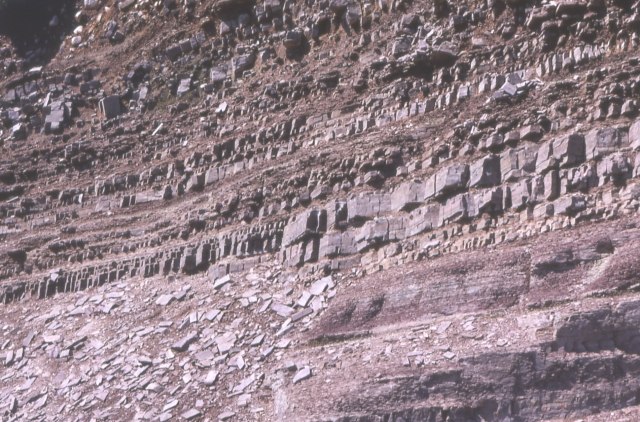The Hebridean Terrane is one of the terranes that form part of the Caledonian orogenic belt in northwest Scotland. Its boundary with the neighbouring Northern Highland Terrane is formed by the Moine Thrust Belt. The basement is formed by Archaean and Paleoproterozoic gneisses of the Lewisian complex, unconformably overlain by the Neoproterozoic Torridonian sediments, which in turn are unconformably overlain by a sequence of Cambro–Ordovician sediments. It formed part of the Laurentian foreland during the Caledonian continental collision.
Outcrop of weathered Lewisian gneiss, 5 km NW of Loch Inver
Well-bedded Torridonian sandstone
Pipe Rock viewed on a bedding surface
Durness Group dolomite exposed at the entrance to Smoo Cave in Durness
The Moine Thrust Belt or Moine Thrust Zone is a linear tectonic feature in the Scottish Highlands which runs from Loch Eriboll on the north coast 190 kilometres (120 mi) south-west to the Sleat peninsula on the Isle of Skye. The thrust belt consists of a series of thrust faults that branch off the Moine Thrust itself. Topographically, the belt marks a change from rugged, terraced mountains with steep sides sculptured from weathered igneous, sedimentary and metamorphic rocks in the west to an extensive landscape of rolling hills over a metamorphic rock base to the east. Mountains within the belt display complexly folded and faulted layers and the width of the main part of the zone varies up to 10 kilometres (6.2 mi), although it is significantly wider on Skye.

The Glencoul Thrust, part of the Moine Thrust Belt, dipping downwards from left to right, where Precambrian Lewisian gneiss has been pushed along the thrust fault and now lies above younger well-bedded Cambrian quartzite, which itself lies unconformably above Lewisian gneiss
The Moine Thrust at Knockan Crag, in the central section of the thrust belt. Neoproterozoic Moine schists are thrust over Cambrian–Ordovician Durness Group dolomites






